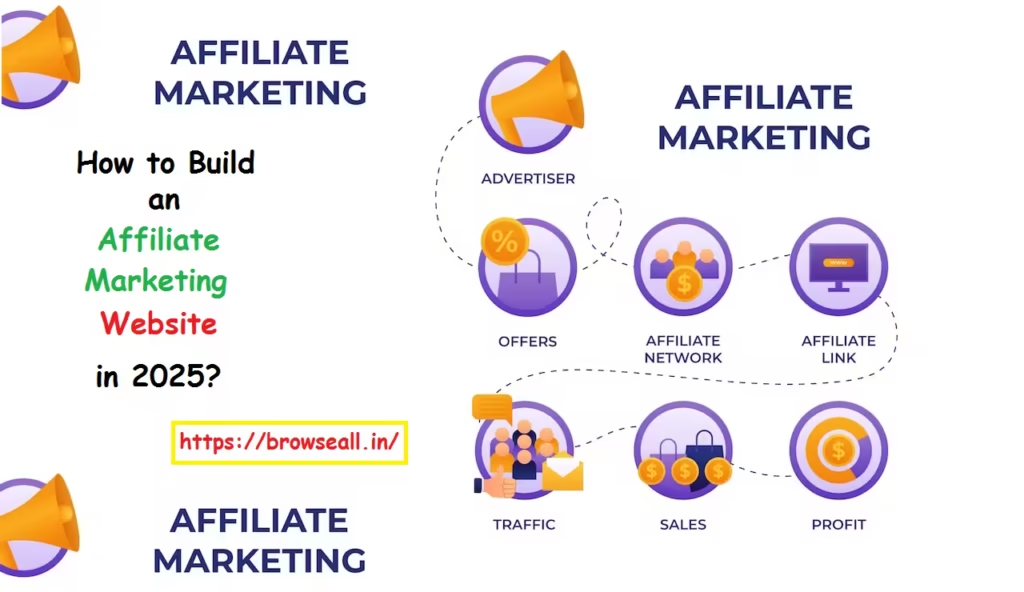Build an Affiliate Marketing Website - Master Plan - Growth Strategies
Starting an affiliate marketing website is one of the best and easiest ways to earn passive income online. You don’t need to create your own product — just promote trusted products and earn a commission for every sale. In this post, you’ll learn step by step how to plan, build, and grow a successful affiliate website — from choosing your niche and writing SEO-friendly content to driving traffic and increasing sales.
How to Build an Affiliate Marketing Website - Step 1 - Choose a niche (the right topic)
Good niche = interest + buyers + low-to-medium competition.
How to pick:
1. Pick something you understand or can research (example: fitness gadgets, kitchen tools, online courses).
2. Prefer niches where people buy online (tools, software, courses, gadgets).
3. Validate demand: search Google for product names + "review", "best", "buy".
4. Niche checklist: focused topic, enough products to promote, at least some search volume.
Example networks you can join later: Amazon Associates, ClickBank, ShareASale, CJ, Digistore24 (if you want digital products). Choose networks relevant to your niche.
How to Build an Affiliate Marketing Website - Step 2 - Keyword & competitor research (plan your content)
Why:
you must write content that real people search for.
Simple process:
1. Make three keyword lists:
a. Transactional (buying intent): "best [product]", "[product] review", "[product] vs [product]".
b. Informational (learn-first): "how to use [product]", "best ways to [achieve outcome]".
c. Commercial investigation: "top 10 [category]", "cheap [product] for [use case]".
2. Find competitors: search your keywords and note the top 5 sites.
3. Make content gap list: what competitors miss? (examples: updated price, local options, video demos).
Actionable: create 30 seed topics (10 review posts, 10 how-to posts, 10 list/comparison posts).
How to Build an Affiliate Marketing Website - Step 3 - Domain, hosting & site setup
Keep it simple and professional.
Domain tips:
1. Short, easy to type, brandable. Keyword in domain is optional.
2. Use .com/.in or local TLD if you target a country.
Hosting & platform:
1. Use WordPress (flexible and beginner-friendly).
2. Choose reliable shared or managed hosting (fast, with SSL).
Essential plugins/tools:
1. SEO plugin (Yoast or Rank Math).
2. Cache plugin (for speed).
3. Security plugin.
4. Image optimization plugin.
5. Affiliate link manager (Pretty Links, ThirstyAffiliates) — for tracking/cloaking.
6. Schema/review plugin (adds star ratings in search results).
Site structure (start simple):
1. Home.
2. Blog / Reviews (main content).
3. Category pages (by product type).
4. About.
5. Contact.
6. Privacy Policy & Affiliate Disclosure.
7. Sitemap.
Important: add a clear affiliate disclosure page and a short disclosure near affiliate links (
"I may earn a commission…").
How to Build an Affiliate Marketing Website - Step 4 - Content strategy & article templates
Types of posts that convert best:
1. Product reviews (single product).
2. Product comparisons (A vs B).
3. Roundups (Top 7 for [use case]).
4. How-to / tutorial posts using the product.
5. Best-of lists (seasonal gift guides).
Product review template (use this every time):
1. Title: "[Product] Review — Is it Worth Buying in 2025?".
2. Short intro: what it does and who it’s for.
3. Quick verdict + score (1–5).
4. Pros & cons (bullet list).
5. Key features and benefits.
6. Real use cases / who should buy it.
7. Alternatives / compare table.
8. Price & where to buy (affiliate button).
9. FAQ.
10. Final call-to-action (CTA).
CTA examples:
1. "Check latest price on Amazon".
2. "See current discount →".
3. "Buy now (limited stock)".
Always add: images, videos (even short phone demos), and a comparison table near the top for skimmers.
How to Build an Affiliate Marketing Website - Step 5 - On-page SEO & technical basics
Make it easy for Google and users.
On-page checklist:
1. Use target keyword in title, H1, and first 100 words.
2. Keep meta descriptions clear (not too long).
3. Use descriptive URLs (example.com/product-name-review).
4. Add alt text for images.
5. Add structured data for reviews (schema) so Google can show stars.
6. Internal linking: link from category pages to your best posts and vice versa.
7. Mobile-friendly & fast-loading pages.
Technical checklist:
1. SSL (HTTPS).
2. Fast host + caching.
3. Compress images.
4. Use a simple, readable theme.
5. Create an XML sitemap and submit to Google Search Console.
How to Build an Affiliate Marketing Website - Step 6 - Conversion optimization (turn visitors into buyers)
Make buying easy and trustworthy.
Best practices:
1. Show clear CTAs above the fold + at the end of article.
2. Use comparison tables with "Best for" labels.
3. Add scarcity or discount info when real (e.g., "20% off today").
4. Use trust signals: real user reviews, star ratings, tested photos.
5. Use an affiliate link tracker to measure clicks.
Popups & forms:
1. Use exit-intent popup for an email capture (offer a short checklist or discount code).
2. Keep popups light — don’t annoy users.
How to Build an Affiliate Marketing Website - Step 7 - Build an email list & sales funnel
Email turns casual visitors into repeat buyers.
Simple funnel:
1. Lead magnet: create a small freebie (PDF checklist, top 10 product picks, coupon list).
2. Welcome email (deliver the freebie).
3. 2–3 value emails (helpful guides).
4. 2–3 promotional emails (your best product recommendations + links).
Email tools: MailerLite, ConvertKit, or Mailchimp (choose one and integrate with your site).
Example email sequence (3 emails):
1. Day 0: Welcome + freebie.
2. Day 3: Helpful guide + link to top products.
3. Day 7: Best deal this month + strong CTA.
Build an Affiliate Marketing Website - Step 8 - Traffic growth strategies
You need visitors. Use several channels.
Organic (best long-term):
1. Publish helpful, in-depth posts (1,200–2,500+ words for pillar content).
2. Use topic clusters: create a big "pillar" post and many related smaller posts linked to it.
3. Build backlinks: guest posts, resource pages, outreach, and HARO responses.
4. Optimize older posts regularly (update prices, add images).
Social & content repurposing:
1. Create short videos (YouTube Shorts, Reels, TikTok) showing product demos.
2. Pin post images on Pinterest (great for buyers).
3. Post helpful answers on Quora and link to relevant articles (don’t spam).
4. Repurpose article into slides, short videos, and tweets.
Paid (use carefully):
1. Google Ads for high-intent keywords (note: some ad networks have policies on affiliate links; instead send ads to your site).
2. Facebook/Instagram ads for product demos or lead magnets.
3. Test small budgets, track ROI closely.
Partnerships & influencers:
1. Collaborate with micro-influencers for reviews.
2. Offer coupon codes to partners for easy tracking.
Build an Affiliate Marketing Website - Step 9 - Measure & improve (important metrics)
Track performance and optimize.
Key Metrics to watch::
1. Traffic sources (organic, social, paid).
2. Click-through rate (CTR) on affiliate buttons.
3. Conversion rate (visitors → buyers).
4. Average order value (AOV).
5. Revenue per visitor (RPV).
6. Email open & click rates.
7. Top-performing pages.
Tools:
1. Google Analytics (GA4) — track users and goals.
2. Google Search Console — keyword impressions and clicks.
3. Affiliate dashboard — clicks and earnings.
4. Heatmaps (Hotjar) — optional for CRO.
Use data: update low-traffic pages, improve CTAs on pages with clicks but low conversions, and scale what works.
Build an Affiliate Marketing Website - Step 10 - Compliance & trust (don’t skip this)
1. Always show an affiliate disclosure near links ("I may earn a commission").
2. Use rel="sponsored" or rel="nofollow" on affiliate links if required.
3. Add Privacy Policy and Terms of Use.
4. Follow each affiliate program’s rules (some forbid using their trademark in domain names or ads).
Use data: update low-traffic pages, improve CTAs on pages with clicks but low conversions, and scale what works.
Build an Affiliate Marketing Website - Step 11 - Scale & diversify income
Once you have steady traffic:
1. Negotiate direct deals with brands (better commissions).
2. Add display ads (AdSense) to diversify.
3. Sell sponsored posts, product placement, or featured listings.
4. Create your own digital product (ebook, course) and promote it.
5. Build comparison tools, calculators, or interactive widgets (boost conversions).
Build an Affiliate Marketing Website - Conclusion
Building an affiliate marketing website takes time, effort, and smart planning — but with the right strategy, it can become a long-term source of passive income. Focus on helping your audience, publishing useful content, and promoting quality products you trust. Keep learning, tracking results, and improving step by step. With consistency and patience, your affiliate website can grow into a profitable online business.
You can get How to Start an Affiliate Marketing Website? in 2025. We can't guaranteed to given 100% accurate information but we will try to give the best knowledge to you. Please read the carefully our disclaimer and privacy policy information. See kolkata ff result old chart Click here to know more.







My programmer is trying to convince me to move to .net from PHP.
I have always disliked the idea because of the expenses.
But he’s tryiong none the less. I’ve been using
Movable-type on several websites for about a year and am
worried about switching to another platform. I have
heard excellent things about blogengine.net. Is there a way I can import all my wordpress posts into it?
Any kind of help would be really appreciated!
Thanks. Visit again.
Hey! I just wanted to ask if you ever have any problems with hackers?
My last blog (wordpress) was hacked and I ended up losing
a few months of hard work due to no back up.
Do you have any solutions to prevent hackers?
Thanks. Visit again.
vialand ticket price 2025 istanbul Everything about our trip exceeded expectations — clean transportation, professional staff, and a great selection of attractions. We couldn’t be happier with the service. https://tr.linkedin.com/in/workshoptravelshop
Thanks. Visit again.
Get More Information jaxx liberty download
Thanks. Visit again.
linked here https://liquity.cfd/
Thanks. Visit again.
click here to investigate https://avalonfinance.cv/
Thanks. Visit again.
that site https://terminal.credit
Thanks. Visit again.
he said https://hypperswap.space
Thanks. Visit again.
right here https://etherealtrade.rest
Continue Reading https://dexrp.wtf/
Thanks. Visit again.
Thanks for sharing. I read many of your blog posts, cool, your blog is very good.
Thanks. Visit again.